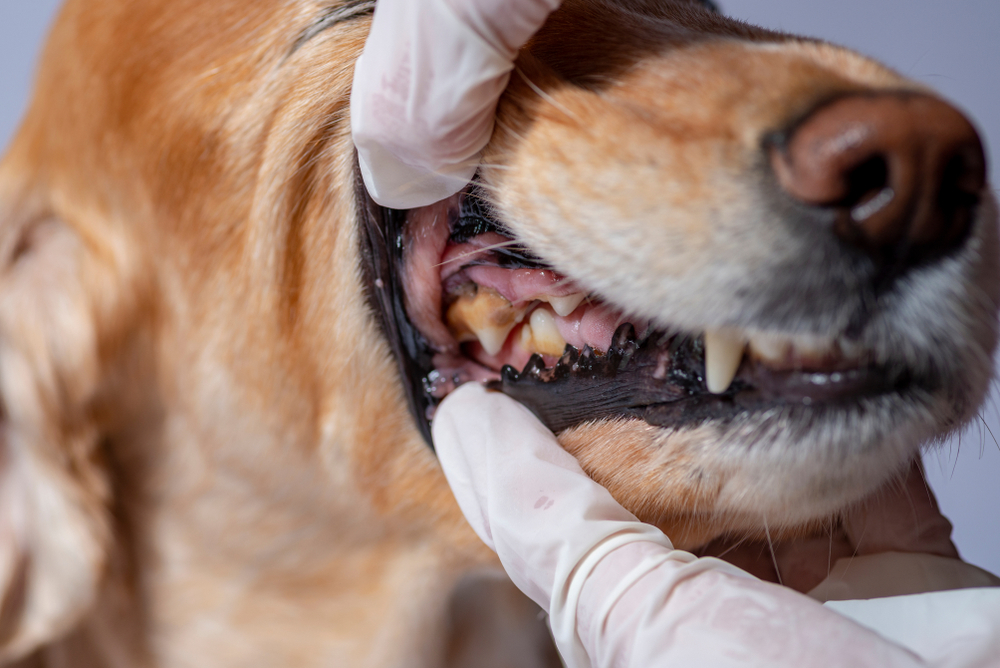Up to 85% of pets over age 3 have some form of dental disease. If you’ve never brushed your pet’s teeth or had their teeth professionally cleaned, we want to share why these essential dental care routines are critical to your pet’s health. Our team at Greenfield Veterinary Clinic explains what causes dental disease in pets and the steps you can take to reduce your pet’s risk.
Dental disease in pets is more serious than bad breath
Like people, pets develop dental plaque and tartar. You brush your teeth daily and visit the dentist regularly for teeth cleanings to remove plaque and tartar buildup, and it makes sense that your pet requires the same level of care. When your pet eats, food particles, bacteria, and plaque accumulate quickly. Plaque can be removed easily with regular toothbrushing, but it eventually will build up and harden into cement-like tartar if routine brushing is neglected. As tartar builds up on and under the gumline, it traps bacteria and causes painful inflammation (i.e., gingivitis), and the dental disease progresses. Dental disease is not only unpleasant, but also painful, and can lead to more serious problems, such as bone loss, tooth loss, infection, and heart and kidney problems.
Pet owners often believe that stinky dog or kitty breath is normal, but it actually can be a sign of dental disease. Along with bad breath, you may notice tooth discoloration because of tartar accumulation, particularly on the large canine teeth. Other signs include:
- Red, swollen gums
- Broken or loose teeth
- Excessive drooling
- Decreased appetite
- Swallowing food whole, instead of chewing
- Leaving broken crumbs around their bowl after eating
- Taking food from their bowl and eating it somewhere else
- Blood in their water bowl or on their toys
- Shying away from being touched near their face
Professional teeth cleaning protects your pet’s dental health
Pets require regular checkups and cleanings to maintain good dental health. A close examination of the teeth is a crucial part of your pet’s annual wellness exam. A professional cleaning may be recommended, along with dental X-rays to show the 60% of dental problems that exist under the gumline and cannot be directly seen. Proper cleaning and dental X-rays can only be performed thoroughly and safely with your pet under general anesthesia. Once your pet is under anesthesia, your veterinarian will use specialized instruments, such as an ultrasonic cleaner, to remove plaque that has mineralized to tartar. If your pet’s X-rays show serious tooth root damage, further treatment, such as tooth extractions, may be required. A complete professional pet teeth cleaning will include:
- Scaling tartar from the surface of the teeth, above and below the gumline
- Polishing each tooth to remove microscopic etchings created by scaling and to which bacteria can adhere
- Probing the gumline for pockets that indicate periodontal disease
- Irrigating below the gumline to flush away bacteria and debris
- Rinsing with an antimicrobial solution
Supplement your pet’s teeth cleanings with regular teethbrushing

Professional dental cleanings are one component of thorough dental care for your pet and should be combined with at-home, twice-daily teethbrushing. If you’ve never attempted to brush your pet’s teeth, use these tips to get started:
- Use pet-specific toothpaste — When teaching your pet to accept toothbrushing, remember to use fluoride-free toothpaste designed for pets, which comes in a variety of tasty flavors like beef, chicken, and fish.
- Train your pet to accept teethbrushing — Train your pet to accept teethbrushing by first offering a small amount of toothpaste on your finger, and then a dollop squirted onto a baby toothbrush, finger brush, or pet-friendly toothbrush.
- Focus on the outer surfaces — Give your pet’s teeth a quick scrub, focusing on the outer surfaces, since the tongue will work to clean the inner surfaces. Keep it quick, and follow up with praise and a treat to make it a positive experience.
- Use dental products to supplement brushing — Many products, including prescription dental diets, chews, water and food additives, and oral sprays and wipes, can help. Use only products bearing the Veterinary Oral Health Council’s seal, because those are proven to slow plaque and tartar buildup.
Your pet’s dental health is a critical part of their overall wellbeing, and you have the tools to keep them pain- and dental disease-free. If your pet is showing signs of dental issues, quick attention can prevent the problem from becoming worse. Contact our Greenfield Veterinary Clinic team to schedule their wellness examination and dental evaluation or cleaning, or to discuss at-home dental care.







Leave A Comment